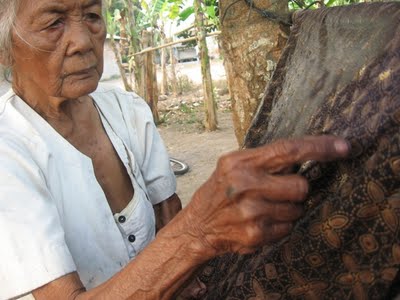Mbah Karyo ("Mbah" is a Javanese term for men or women who already have a grandchild or a person who are elderly) may not know if UNESCO had set batik from Indonesia as the human cultural heritage is not the object. But the old woman is still eager to participate and create a masterpiece of art, Batik !

Every day Mbah Karyo 100-year-old is brushing wax on batik cloth. A sheet of printed Batik cloth draped over a bamboo stick in between two trees. After soaking Batik cloth, using tools of iron, she curry wax on a particular part of the Batik motifs. Old hand was still quite strong and agile.
"Part of this scrape I will be red," said the woman who lived in Keloran village, disctric of Bantul, Yogyakarta. Every day she completed four pieces of cloth. But Batik cloth was not hers. Mbah Karyo is a Batik workers for each piece of Batik cloth, she paid for Rp.2000 (less than a quarter of US$ 1).
Mbah Karyo is one of the millions of Indonesian Batik craftsmen who depend their lives from the job. A simple person who does not realize that from the work of his hands, Batik Indonesia was recognized by the world.
World through UNESCO has established, Batik is Indonesian native culture which has existed since hundreds of years ago. Batik is a culture, part of the life of the Javanese in particular.
The existence of Batik built with fortitude by simple people like Mbah Karyo, who despite making a piece of Batik cloth only paid a very cheap, but with Javanese culture that flows in her blood, making a piece of Batik cloth is an honor that she gave to his ancestors.






